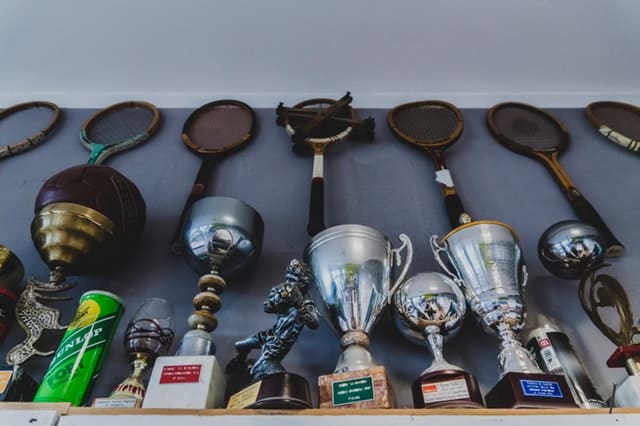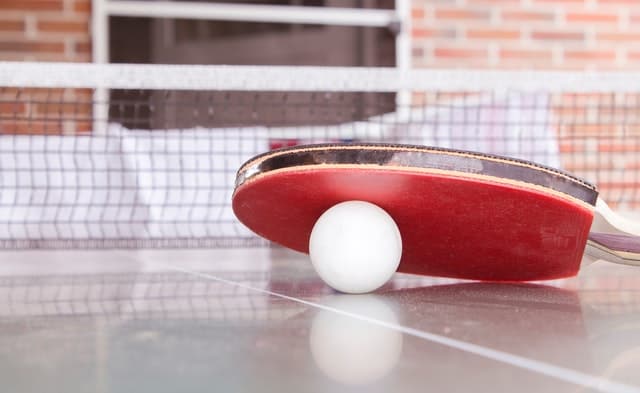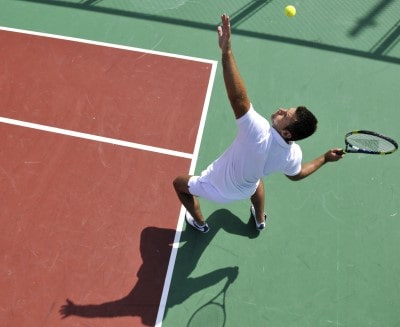When I first started playing tennis, one of the more daunting parts of being a beginner was picking out equipment. And the most important piece of equipment in tennis is the tennis racquet.
When I’d go to a sporting goods store, I’d see shelf after shelf and row after row of gleaming, colorful racquets. But what makes one racquet better than another? What are the fundamentals when it comes to tennis racquets?
I’ll cover a thorough description of the tennis racquets. By the end of it, you’ll have a strong understanding of what a tennis racquet is, how it’s used and what makes a good one.
What is Racquet?
A tennis racquet is an object used while playing tennis to strike the ball over the net onto your opponent’s side of the court. The three fundamental items you need to play the sport of tennis. They are a tennis ball, a tennis racquet, and a tennis court to play on.
Here, I’ll walk you through the basics of tennis racquets.
First of all, let’s talk about the basic form of a tennis racquet.
At its simplest, a tennis racquet consists of a handle, a frame, and a surface made of criss-crossed strings.

The handle of a tennis racquet is usually anywhere from 7 inches to a foot long and is usually molded from soft plastic or foam, or else wrapped in a surface that helps with grip. Playing tennis can often time lead to sweating profusely, and you want a handle you won’t lose grip on even then.
The frame of a tennis racquet is made of a metal or hard composite material and forms an ovaloid shape. The size of the frame depends on how large a hitting surface the player wants. There are pluses and minuses to a large or small frame, which I’ll cover later.
Finally, the hitting surface itself, which is made up of a series of strings made of a variety of materials. The strings run at 90-degree angles from one another to form a criss-crossing mesh.
Usually, the squares in the grid are no more than about a half an inch in area. This means that there’s no point where the tennis ball can pass through.
Racket vs. Racquet
Depending on what you’re reading, you might see it spelled as ‘racquet’, while other times you’ll see ‘racket’. They both refer to the same thing. But which is right?
Never fear – The answer is pretty straightforward.
The short answer is that either can be correct. Both are acceptable spellings for a tennis racquet/racket. And the good news is that they’re pronounced the same, so when you’re talking, there’s no distinction to be made.
The reason there are two spellings is that tennis is an international game, and certain terms and ways of spelling gained prominence over time.
Originally, the spelling was ‘racket’. In the 1800s, French influence on the game caused ‘racquet’ to be a preferred spelling.
In North America, the original ‘racket’ spelling is slightly preferred. In the UK, ‘racquet’ is the preferred spelling. However, tennis equipment manufacturers use both terms, and regardless of your location. You’ll see both spellings, often time on the same website or store.
The bottom line is that you’re not wrong for using either spelling. Depending on your audience or the people you’re communicating with, you might be standing out from the norm. But either way, everyone is going to know what you’re talking about.
One minor point that might be in ‘racquet’’s favor – The word ‘racket’ has a second meaning, which is a loud noise, commotion or din. There’s no alternate meaning for ‘racquet’, so in some rare situations, you may avoid confusion by using ‘racquet’.
Racquet Sports
Tennis is the most popular sport played with racquets, but it’s far from the only one. Here are some of the sports played using a racquet besides tennis.
Badminton
Badminton is a sport similar to tennis, in which a player or team takes turns hitting a shuttlecock across a net until the shuttlecock hits the ground.
The biggest distinguishing feature about badminton is the shuttlecock, which is a high-drag object with feathers on the end of it. A shuttlecock flies through the air in a distinctive way that defines the game.
Badminton racquets are lightweight, with a longer handle than most other racquets.
Racquetball
Racquetball is a game played within either an indoor or outdoor walled court. Rather than having a net, in racquetball, the object is to take turns hitting the ball off the walls until a player can’t return it.
A racquetball racquet is distinguished by its short handle and slightly smaller hitting surface than a tennis racquet.
Squash
Squash is a game very similar to racquetball, in that it’s played in a four-walled court. Like in racquetball, players take turns hitting the ball off walls until it can’t be returned, though the rules vary in a number of places compared to racquetball.
A squash racquet is similar in length to a badminton racquet, though it’s far more substantial. This is because the used in squash is heavier than the shuttlecock used in badminton.
Rackets
Rackets is a sport identical in many ways to squash. In fact, squash came from rackets, which is considered its predecessor. The rules vary slightly, but the basic aim of the game is the same in each case.
A rackets racquet is very similar to a squash racquet, to the point where you could play either game with the same equipment.
Table Tennis or Ping Pong
Table tennis (known in some areas as ping pong) is a game played on a table that resembles a miniature tennis court. The game plays very similarly to tennis, except that the court is much smaller and the ball is far lighter.

A table tennis racquet is also much smaller than a tennis racquet and is made of wood or a variety of lightweight substances. A rubber or plastic grip is on the hitting surface, which allows for more control of the ball when hitting.
Real Tennis
Real tennis is a slightly archaic game which resembles tennis and other racquet sports. The rules are in many ways more complicated than the other racquet sports, and are difficult for a casual observer to understand.
Real tennis is played in very few locations in modern times.
A real tennis racquet is similar to a squash or rackets racquet.
Tennis Racquet String
In many ways, the most important part of a tennis racquet is the racquet string. That’s because this is the point of contact when you hit the tennis ball.
Over the years, manufacturers have made racquet string from a number of substances, each with different properties. Technology has allowed for the creation of many new compositions for tennis strings in recent years.
Natural Gut
The first standardized substance used for racquet strings were the intestines of animals. The term ‘catgut’ became a catch-all name for these, but they’re traditionally made from sheep or cow intestines.
These strings are softer and retain tension better than other substances. This translates to preserving the energy of a shot into a return better than other types of strings.
There are two main problems with natural gut strings. The first is the expense involved in producing racquets made from them. The second is their lack of durability.
Natural gut strings break down easily when subjected to water. For an outdoor sport when rain is a possibility, this can be a problem. Off-center contacts on natural gut strings can also cause the strings to weaken and break.
Synthetic Gut
Synthetic gut strings are usually produced from nylon and are always a single filament. These strings are inexpensive to produce, though their performance isn’t as good as other types.
The synthetic gut is occasionally mislabeled as ‘sheep gut’, though no organic material is involved in its production.
Multi-filament
Multi-filament strings are a step up in quality from the synthetic gut. Because the strings consist of multiple filaments, these strings have more elasticity for better ball striking. The downside is that single filament strings are more durable.
Types of Synthetic Gut and Multi-filament Strings
The materials used to make up the single filament synthetic gut and multi-filament strings make a huge difference in performance. They also each have their own drawbacks and benefits.
Nylon is the most frequently used string for new players. It’s durable and cheap, and works well for both single and multi-filament strings.
Polyester is a material most frequently used by professional players. The reason is that using polyester strings allows players to apply more topspin to their shots.
Kevlar strings come closest to natural gut strings when it comes to elasticity and responsiveness. The downside is that using Kevlar strings can lead to tennis elbow. Tennis elbow is a condition in which the elbow becomes inflamed due to repetitive elbow motions, and can be debilitating.
Modern composites like Vectran, Zyex and Polyolefin are advanced creations specifically designed for racquet strings. They’re engineered to come as close to the natural gut as possible when it comes to performance.
These composites can sometimes be expensive, and each has its specific strengths and weaknesses. But they deliver excellent performance for those don’t want to pay for natural gut strings.
Tennis Racquet Grip
When it comes time to buy your first tennis racquet, one of the most important parts of that process is choosing a racquet with the correct grip size.
If you get a racquet with too small a grip, you’ll have to expend more strength to use it. In addition, a too-small grip can lead to developing tennis elbow.
A racquet with a grip too large will make serving and executing certain shots more difficult. It too can lead to a higher risk of injuries.
Fortunately, it’s fairly simple to pick out a racquet with a proper grip size. You just need to know what you’re looking for.
The first way to measure your hand for a grip is something you can do without even having a tennis racquet to measure against. If you have a tape measure or ruler, measure your hand from the middle crease on your palm to the tip of your ring finger.
That measurement represents the diameter that your grip should be. This method can be especially good if you’re going to be ordering a racquet online or by some remote means.
If you’re buying a racquet in-person, you can directly measure your hand against the racquet. Pick up the racquet in a ‘handshake grip’, holding it firmly. Once holding it, place your index finger in the gap between your fingertips and the bottom of your palm.
Does your finger not quite fit? If so, the grip is probably too small. Is there extra room to the side of your finger? The grip is too large.
By using these two techniques, you can get a good sense of how big your racquet’s grip should be.
And don’t worry if you buy or inherit a racquet with a too-small grip. It’s easy to wrap something called overgrip around the grip. Overgrip is an adhesive substance similar to tape, and it will extend the size of your grip to your specifications.
Choosing a Tennis Racquet
String types. String tensions. Racket frame size. Racket weight. There are so many variables that go into the different tennis racquets that it can seem overwhelming to even think about choosing one.
But here’s the truth about picking out a racket: Only a few things matter to a newer player, and they’re pretty simple once you get the idea.
Sure, the pros can deliberate over a difference of a few ounces of a slightly wider frame, but most of that doesn’t matter to you.
All you care about is having a racquet that will unlock your potential and help you improve.
Here are the factors that go into picking out a racquet.
Surface Area: Control vs. Power
Tennis racquets come with a wide range of hitting surface areas. You’d think that the bigger surface area, the better, right?
Yes and no. There are advantages to a bigger surface area, and drawbacks as well.
The biggest plus to a huge surface area is that it’s easier to hit the ball in the ‘sweet spot’. When hitting a tennis ball, you don’t want to hit it toward the side of the hitting surface. This produces bad contact.
The bigger the surface, the bigger the sweet spot. So, if you’re not that accurate like most beginners aren’t, a bigger surface is helpful.
On top of that, a bigger hitting surface can generate more power and spin. It sounds like you’d never want anything but a big surface.
But you’re giving something up for those benefits: Control. The smaller the hitting surface, the more accurate your shots will be. That’s why more advanced players tend to favor smaller hitting surfaces.
As a beginner, go with a nice, generously large hitting surface. After you’ve played for a while, you can test the idea of decreasing your racquet’s surface area.
Racquet Weight
Tennis racquets range in weight from very heavy ones to extremely lightweight ones. Why the variation?
The main reason is that we’ve got another one of these trade-offs.
A heavy racquet is especially useful for people who can’t generate as much power on their own. The heavier the racquet, the more power is imparted onto the shot.
A lighter racquet doesn’t create as much extra power. But wielding a lighter racquet lets a player exercise more control when striking the ball.
In some ways, it’s similar to the surface area tradeoff – Newer players like heavier racquets, more experienced ones like lighter ones.
But there’s one extra consideration. People with smaller frames and who aren’t as muscular tend to like heavier racquets that multiply their power. Larger folks and those who are more muscular can benefit from lighter racquets.
Head Heavy vs. Grip Heavy
In addition to the raw weight of a racquet, there’s the issue of where the weight is distributed. A racquet could have the majority of weight centered in the frame and hitting surface (the head), the majority in the grip, or it could be balanced.
Head heavy racquets provide extra power. They’re great if you plan to stand at the baseline and hit groundstrokes.
Grip heavy racquets are easier to maneuver and allow for more control on ball placement when you strike it. Players who like to rush the net and hit volleys prefer more grip heavy racquets.
As a newer player, you’ll probably want a heavier racquet with a large surface area, and with a slightly head heavy weight ratio. Those are the attributes that will give you a racquet you’re most likely to succeed with.
Summary
It’s probably safe to say you didn’t expect to ever know so much about tennis racquets as you do now!
While it may seem complicated at first glance, it’s very important to get a racquet that’s right for you. A racquet with the right dimensions and grip size will make tennis seem far easier. The wrong racquet will make it feel much harder than it should be.
Taking a little time to learn how to pick out the proper racquet will pay off as you continue to learn the sport of tennis.
Additional Resource: Best Tennis Racquet Brand.


